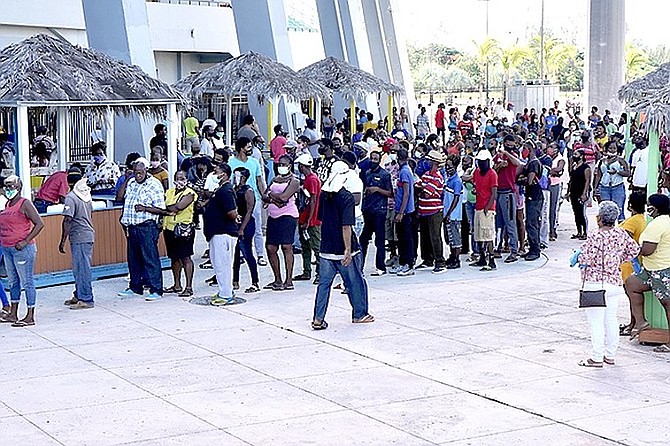Hundreds flocked to the Thomas A Robinson National Stadium Monday, August 11, 2020 to collect assistance cheques from the NIB as a result the COVID pandemic and lockdown.
By NEIL HARTNELL
Tribune Business Editor
nhartnell@tribunemedia.net
The Government had paid out more than $200m in COVID unemployment benefits at end-September 2021, it was revealed last night, although overall pandemic spending seems to be slowing.
Its fiscal “snapshot” for the 2021-2022 first quarter showed a further $39.4m in total COVID-related assistance was paid out during those three months, with unemployment aid accounting for almost two-thirds or $29.7m of that figure. Food assistance accounted for a further $8.8m.
The outlay indicates why the Government has elected to extend COVID unemployment benefits to December at least, and shows that despite the economy’s continued post-pandemic re-opening there are still thousands of Bahamian workers either on furlough or unemployed.
The furlough period’s end on December 13 will provide better insight into just how badly the pandemic has disrupted the jobs market, as employers will have to determine whether to bring back furloughed workers or release them.
It is unclear, too, whether the Government’s data includes the 13-week unemployment benefits payouts provided by the National Insurance Board (NIB). If it does not, then the total COVID jobless outlay is likely to be closer to $300m.
In total, the Government has spent some $392.1m across three fiscal years in combating the pandemic’s devastating effects, with the bulk of the spending - some $273.3m - incurred during the 2020-2021 fiscal year. Food assistance accounts for some $51.2m, while the job retention scheme’s and small business loans’ share are $44.4m and $43.1m respectively.
Elsewhere, government subsidies to loss-making state-owned enterprises (SOEs) rose by $20m or 20.8 percent to $116.2m compared to the same fiscal period in 2021-2022.
This total included additional transfers of $12m to the Public Hospital Authority (PHA) as the country continues to combat the coronavirus pandemic, as well as transfers of $6.6m to Water and Sewerage and $3.3m to Bahamasair as both entities remain challenged during the coronavirus related economic downturn,” the report said.
Social assistance benefits firmed by $1.9m (4.2 percent) to $48.4m, representing 41.8 percent of the budget [and] primarily driven by the continued social economic assistance provided to the public during the current economic crisis.
“Current transfers not elsewhere classified contracted by $0.9m (2.3 percent) to $39.2m (21.3 percent of the budget), reflecting major reductions in transfers to Bahamas Civil Aviation ($3.5m); Airport Authority ($1.9m); and Nassau Flight Services ($0.6m),” the report added.
“With the removal of travel restrictions in place in the same period of the prior year, and the signed air space agreement with the US government allowing for increased direct revenue for air traffic-related services, Government operational support is reduced.”
Meanwhile, interest payments on the Government’s debt increased by $11.7m or 14.5 percent to $92.2m, a sum equal to 19.1 percent of the full-year Budget total due to the elevated level of COVID-related borrowings.
“Compensation of employees expanded by $11.6m (6.8 percent) to $180.7m, as compared to the same period in the prior year, and represented 23.2 percent of the budget target,” the report said.
“This increase was largely explained by period-over-period expansions in salaried employment ($9.9m); discretionary allowances ($1.9m); summer employment ($1.2m); overtime ($0.3m); and special employment programmes ($0.1m).
“The elevated level of spending is largely attributed to the resumption of promotions, staff reclassifications, payment of increments and other employee costs deferred in the past year due to fiscal constraints.”
Pointing to a first quarter revenue performance that exceeded Budget targets by $92m, the fiscal “snapshot” said the Government’s net borrowing increased by $154.6m during the three months to end-September 2021 compared to a $692m rise in the year-before period.
“Gross borrowings of $497.4m, compared to $921m in the same period of the prior fiscal year, were used to fulfill budgetary financing requirements as well as to settle maturing debt instruments,” the report said.
“Domestic bond issuances totaled $48.8m to partially cover repayment of $92.3m in maturing securities. Drawings on existing loans from international development agencies aggregated $23.7m.
“Treasury bills and notes of $265m were issued during the period to meet short-term financing needs in Treasury bills, while $160m was received in Central Bank advances to settle an equivalent amount. Owing to improved fiscal conditions, repayments for government debt were elevated at $342.9m compared to $229m in the same period of the prior year.
“As a result of net borrowing activities, the direct charge on the Government - exclusive of exchange rate adjustments - increased by $154.6m to $10.087bn or 98.1 percent of GDP at end-September 2021, as compared to 100.5 percent of GDP at end-June 2021.”





Comments
Use the comment form below to begin a discussion about this content.
Sign in to comment
Or login with:
OpenID